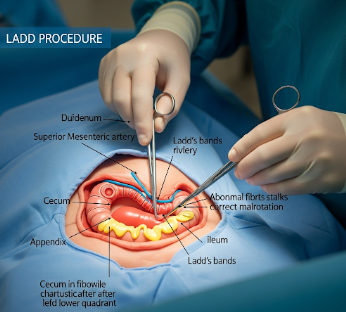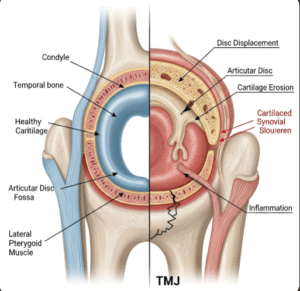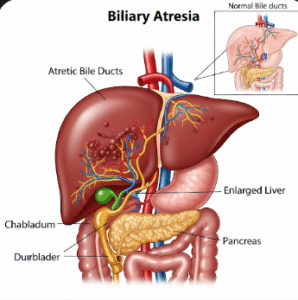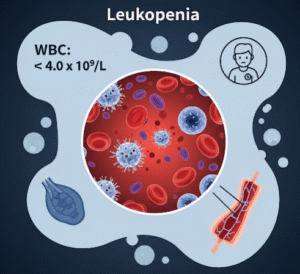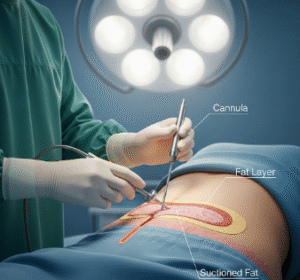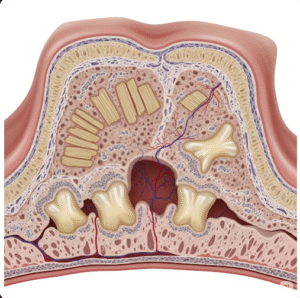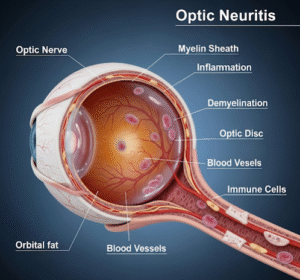Overview
The Ladd Procedure is a surgical operation performed to correct intestinal malrotation, a condition in which the intestines do not develop or rotate properly in infants and children. This procedure is crucial because malrotation can lead to volvulus, a life-threatening twisting of the intestines that can cause bowel obstruction and loss of blood supply.
In Korea, children requiring the Ladd Procedure can access highly specialized pediatric surgeons and advanced surgical facilities, ensuring safe, precise, and effective treatment.
Highlights:
- ✅ Corrects abnormal positioning of the intestines
- ✅ Prevents volvulus and life-threatening complications
- ✅ Available in leading pediatric surgical centers in Korea
What is the Ladd Procedure?
The Ladd Procedure is a surgical operation to reposition the intestines and prevent volvulus. During the procedure, surgeons:
- Untwist the intestines if a volvulus has occurred
- Divide abnormal fibrous bands (Ladd bands)
- Widen the base of the mesentery to prevent future twisting
- Place the small intestine on the right and the large intestine on the left side of the abdomen
This surgery is usually performed under general anesthesia and is considered urgent in cases of volvulus.
What are the benefits?
- Life-saving: Prevents intestinal ischemia and necrosis
- Restores normal bowel function: Allows food to pass normally
- Prevents future complications: Reduces the risk of recurrent volvulus
- Minimally invasive options: Laparoscopic Ladd Procedure is available in some cases
Key benefits highlighted:
- ⚡ Rapid resolution of bowel obstruction
- ⚡ Reduced long-term complications
- ⚡ Improved quality of life for affected children
Procedure Details
1) How should I prepare for the Ladd Procedure?
- Preoperative evaluation: Blood tests, abdominal imaging, and assessment of general health
- Fasting: No food or drink for a specific period before surgery
- Medication adjustments: Stop certain medications as advised by the surgeon
- Consent and education: Parents or guardians should understand the procedure, risks, and recovery process
- Arrange post-surgery care: Ensure support at home for postoperative recovery
2) What happens during the Ladd Procedure?
- Anesthesia: General anesthesia is administered
- Surgical approach: Either open or laparoscopic method
- Untwisting intestines: Surgeons correct any volvulus if present
- Division of Ladd bands: Fibrous bands causing obstruction are cut
- Repositioning intestines: Small intestine placed on the right, large intestine on the left
- Closure: Incisions are closed, and the child is moved to recovery
Duration: Typically 1–2 hours depending on complexity
3) What happens after the Ladd Procedure?
- Recovery room monitoring: Vital signs, pain, and bowel function are closely observed
- Pain management: Medications to control discomfort
- Feeding: Gradual reintroduction of fluids and food as tolerated
- Follow-up care: Regular pediatric surgical visits to monitor healing and bowel function
Highlights for post-operative care: - ⚡ Watch for signs of infection or obstruction
- ⚡ Maintain proper hydration and nutrition
- ⚡ Follow physical activity restrictions as advised
- ⚡ Monitor bowel movements and abdominal symptoms
Risks / Benefits
Risks:
- Infection at the surgical site
- Bleeding
- Adhesions or future bowel obstruction
- Rare anesthesia complications
Benefits:
- Prevention of life-threatening volvulus
- Restoration of normal intestinal function
- Improved long-term gastrointestinal health
Recovery and Outlook
- Hospital stay: Typically 5–7 days for recovery and monitoring
- Full recovery: Most children recover completely within 2–4 weeks
- Long-term outlook: With successful surgery, the risk of volvulus recurrence is significantly reduced
- Follow-up: Regular monitoring ensures healthy growth and bowel function
Tips for optimal recovery:
- ✅ Follow all postoperative instructions from the surgeon
- ✅ Encourage gradual return to normal diet and activity
- ✅ Monitor for signs of complications, including vomiting, fever, or abdominal swelling
When To Call the Doctor
- Persistent vomiting or abdominal distention
- Fever or signs of infection at incision site
- Severe pain not controlled by medications
- Any signs of bowel obstruction (e.g., constipation, bloating, abdominal tenderness)
Best Korea Option / Process
Korea provides state-of-the-art pediatric surgical care for the Ladd Procedure:
- Top hospitals: Experienced pediatric surgeons and multidisciplinary teams
- Advanced diagnostics: High-resolution imaging to confirm malrotation
- Surgical options: Open and minimally invasive laparoscopic procedures
- Postoperative care: Specialized pediatric recovery units and rehabilitation support
- International patient support: Online consultations, hospital scheduling, and telemedicine follow-up
Step-by-step process in Korea:
- Online consultation and review of imaging
- Hospital admission and preoperative evaluation
- Ladd Procedure performed by pediatric surgical specialists
- Postoperative monitoring and follow-up care
- Remote follow-up consultation if patient returns home

